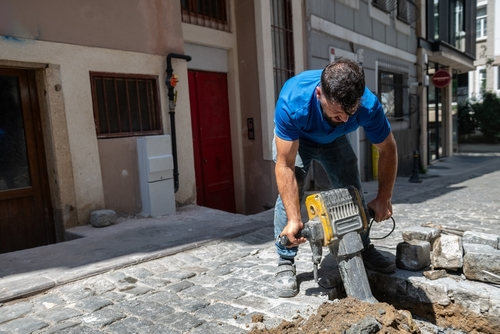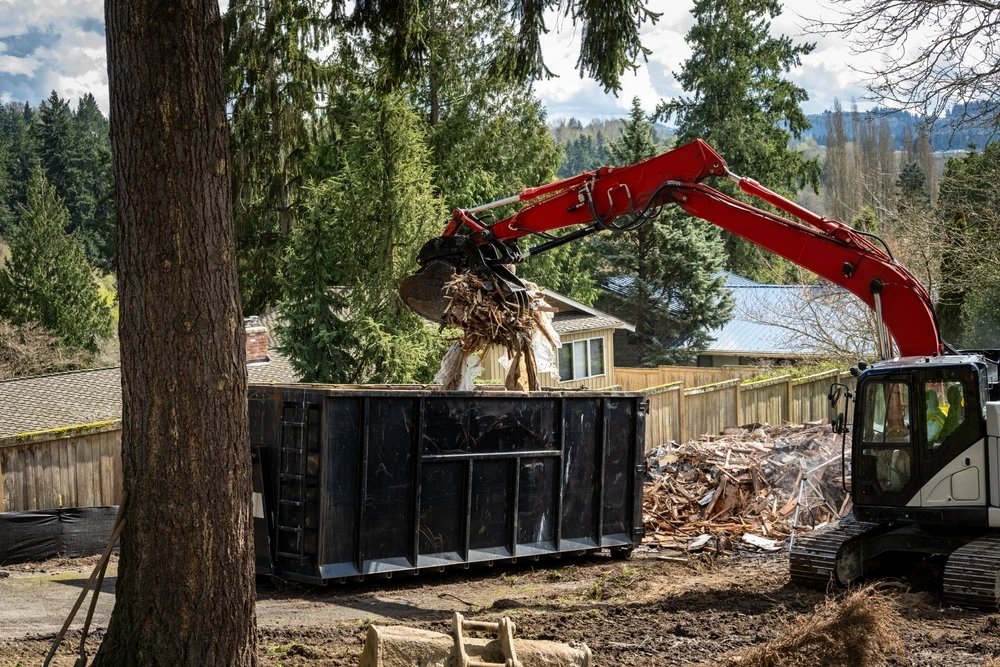Removing asphalt from your driveway or other surfaces can be a daunting task, but it doesn’t have to be. With the right tools and techniques, you can effectively remove asphalt yourself or decide when it’s best to call in professional help. From understanding the most efficient removal methods to learning about safe disposal options, you’ll find everything you need to tackle this home improvement project.
Preparation is crucial for a successful asphalt removal. Start by assessing the condition and size of the asphalt surface. This will help you determine whether you should go for a manual approach or rent machinery like a mini-excavator. Using heavy-duty machines like a Caterpillar 303 excavator, as described in various guides, can make the task run more smoothly. Consider using tools such as a jackhammer for breaking up the asphalt or an electric chipping hammer for stubborn sections. Remember, opting for a concrete dumpster rental can significantly simplify the disposal process of the removed asphalt.
Whether you’re managing the removal on your own or hiring professionals, choosing the right methods and resources is essential. The post-removal phase also includes cleanup, ensuring that the area is ready for whatever comes next—be it new pavement or landscaping projects. Engage with these strategies to ensure that your asphalt removal hones your home improvement skills and transforms your property effectively.
 When selecting a contractor for asphalt removal, focus on evaluating expertise and understanding costs. This will ensure a project that is both efficient and cost-effective.
When selecting a contractor for asphalt removal, focus on evaluating expertise and understanding costs. This will ensure a project that is both efficient and cost-effective.
 After removing asphalt, focusing on proper cleanup and finishing tasks is crucial to achieve a polished look. You’ll want to consider efficient methods for disposing of debris and explore recycling options, as well as finalize the paving area with grading and sealing for enhanced durability and appearance.
After removing asphalt, focusing on proper cleanup and finishing tasks is crucial to achieve a polished look. You’ll want to consider efficient methods for disposing of debris and explore recycling options, as well as finalize the paving area with grading and sealing for enhanced durability and appearance.
 Beginner’s Guide to Dumpster Rentals: Essential Tips for Effective Waste Disposal
Beginner’s Guide to Dumpster Rentals: Essential Tips for Effective Waste Disposal
Date: September 18 ,2024
 Comprehensive Move-Out Cleaning Checklist: Essential Steps for a Spotless Exit
Comprehensive Move-Out Cleaning Checklist: Essential Steps for a Spotless Exit
Date: September 16 ,2024
Key Takeaways
- Consider renting a concrete dumpster for easier disposal of asphalt.
- Choose between manual and machine methods based on surface condition.
- Effective cleanup is essential for post-removal project success.
Preparation for Asphalt Removal
Proper preparation is crucial when removing asphalt to ensure the process is efficient and safe. This involves evaluating the project scope and taking necessary safety measures.Assessing the Project Scope
Before beginning asphalt removal, identify the specific requirements of the project. Determine the size of the driveway or surface area to be removed, as this will influence the equipment and manpower needed. Consider the depth of the asphalt, as thicker layers may require heavier machinery. Evaluate the ease of access to the site. Check if there are any obstructions that might complicate the removal process, like nearby structures or landscaping features. Be aware of any utility lines beneath the surface. Contact local utility companies to mark these areas, preventing damage during removal. Create a checklist of all necessary equipment. This may include jackhammers, asphalt cutters, or bobcats for larger projects. Having the right tools on hand before starting ensures that the process is smooth and avoids unnecessary delays.Safety Considerations and Protective Gear
Safety should always be a priority when engaging in asphalt removal. Equip yourself and your team with appropriate protective gear to minimize risks. This includes sturdy gloves to protect hands from sharp edges and debris. Wearing protective eyewear is essential to shield your eyes from dust and flying fragments. A helmet should be worn at all times to protect against falling debris, especially if using heavy machinery. Ensure everyone on site wears high-visibility clothing to remain visible to machinery operators. Always adhere to local safety regulations and guidelines to maintain a secure working environment. Prepare a first aid kit and keep it accessible in case of minor injuries. Familiarize yourself and your team with emergency procedures, including the location of emergency exits and contacts.Asphalt Removal Techniques
When removing asphalt, you can opt for manual methods with basic hand tools or employ power tools and heavy equipment. Each technique has its advantages and is suited for different project scales and budgets.Manual Removal with Hand Tools
Manual removal is practical for small-scale projects or when precision is required. You will need a shovel and a pickaxe to break up and dig out the asphalt. A pry bar can help lift and remove chunks of material after it’s cracked. Using hand tools is labor-intensive, but it allows for meticulous work without needing access to power sources. A sledgehammer or manual masonry blade may also be used to score and crack through tougher asphalt sections. This method is cost-effective for small areas and offers more control in tight spaces. However, it demands physical effort and can be time-consuming compared to mechanized options.Using Power Tools and Heavy Equipment
For larger-scale projects, using power tools and heavy equipment can significantly speed up the asphalt removal process. A jackhammer is a powerful tool that can quickly break asphalt into manageable pieces. It is ideal if you’re looking to handle medium to large areas efficiently. For cutting through asphalt, a circular saw equipped with a masonry blade can make precise cuts, reducing the size of the asphalt chunks before removal. Heavy machinery like backhoes or excavators can easily tackle large expanses or thick asphalt layers. These machines, while efficient, require skilled operation but will vastly reduce the time and effort needed for removal. Transporting the debris can be done using a pickup truck to manage disposal and ensure your project site stays orderly.Choosing the Right Contractor
 When selecting a contractor for asphalt removal, focus on evaluating expertise and understanding costs. This will ensure a project that is both efficient and cost-effective.
When selecting a contractor for asphalt removal, focus on evaluating expertise and understanding costs. This will ensure a project that is both efficient and cost-effective.
Evaluating Contractor Expertise
To assess a contractor’s expertise, start by reviewing their track record. Look for contractors with extensive experience in asphalt removal projects. Ask for references and check online reviews to gauge their reliability and quality of work. A reputable contractor should provide a portfolio of completed projects. Request a detailed explanation of their removal process. They should clearly articulate the methods and tools they will use. It’s important that they are equipped to handle any challenges specific to your location and project size. Additionally, verify that they possess necessary licenses and insurance coverage to protect against potential liabilities.Understanding Asphalt Removal Cost
Cost is a crucial factor when hiring a contractor. Asphalt removal costs can vary, typically ranging from $1,000 to $3,000 depending on the project size and complexity. Obtain multiple quotes from different contractors for a comprehensive comparison. Pay attention to what is included in each quote, such as labor, disposal fees, and any additional charges. Some contractors might calculate costs per square foot, making it easier to compare bids. Evaluate the contractor’s transparency in explaining the breakdown of expenses. A good contractor will offer a clear understanding of the asphalt removal cost without hidden fees. Good customer service and a willingness to discuss cost details reflect well on a potential hire.Driveway Removal and Replacement
Removing an existing driveway and installing a new asphalt one involves precise planning and execution. The process ensures a long-lasting surface that can withstand daily wear and tear.Removing the Old Driveway
To begin with driveway removal, assess the current condition and decide whether the old surface needs complete demolition. For asphalt, the removal process typically involves using a jackhammer or heavy machinery to break up the asphalt into manageable pieces. This debris is then cleared and properly disposed of according to local regulations. When dealing with a concrete driveway, the steps are similar but may require additional equipment due to its density. Quality removal is crucial for a smooth installation of the new surface.Installing the New Asphalt Driveway
Once the old driveway is removed, focus shifts to installing the new asphalt driveway. Start by grading and excavating the area to achieve the perfect slope for drainage. This step is vital for preventing water accumulation, which can damage the surface over time. A solid sub-base is laid to provide stability. Next, hot asphalt is poured and compacted to form a durable surface. Compacting helps in reducing air pockets and ensuring a long-lasting driveway. Finally, let the asphalt cure properly before using it to ensure its durability and appearance.Post-Removal Cleanup and Considerations
 After removing asphalt, focusing on proper cleanup and finishing tasks is crucial to achieve a polished look. You’ll want to consider efficient methods for disposing of debris and explore recycling options, as well as finalize the paving area with grading and sealing for enhanced durability and appearance.
After removing asphalt, focusing on proper cleanup and finishing tasks is crucial to achieve a polished look. You’ll want to consider efficient methods for disposing of debris and explore recycling options, as well as finalize the paving area with grading and sealing for enhanced durability and appearance.
Debris Disposal and Recycling Options
Handling the debris left after asphalt removal requires careful planning. A heavy debris dumpster rental is the effective choice for managing large quantities of waste. Renting this type of dumpster saves you multiple trips to the landfill, making it both convenient and cost-effective. Recycling old asphalt is an environmentally friendly option. Many asphalt recycling centers accept used materials, which can be repurposed for new paving projects. Check with local facilities regarding their specific requirements for accepting asphalt pieces. Beyond just throwing it away, recycling can offer a second life to the old material. Many paving companies also provide services to grind and reuse crushed asphalt for other construction projects. Reducing landfill use with these methods contributes positively to environmental sustainability.Final Grading and Sealing
Once the asphalt is removed, the next step involves grading, which ensures the surface is even and adequately prepared for any subsequent projects. Proper grading is essential for maintaining drainage and preventing future structural issues. Sealing, or applying a sealcoat, is advisable to protect and extend the life of newly exposed surfaces. This step helps enhance curb appeal by providing a smooth, uniform look. A high-quality sealant acts as a barrier against moisture, oils, and the elements. In some cases, sealing might not be required immediately but keeping the surface well-maintained through regular care ensures lasting benefits. Also, choosing the right materials and methods during grading will significantly impact the durability and performance of the new surface.Frequently Asked Questions
When tackling asphalt removal, understanding the available methods, costs, and machinery is crucial. Removing asphalt can involve manual efforts or professional assistance and involves important safety and cost considerations.What methods are available for removing an asphalt driveway?
Asphalt driveways can be removed using heavy machinery like a skid steer or an asphalt jackhammer. These tools simplify the process and are suited for larger projects. Alternatively, chemical solvents can break down asphalt for easier manual removal.What is the average cost to remove asphalt per square foot?
The average cost to remove asphalt varies depending on factors such as location and project size. On average, you might expect to pay between $1.75 to $2.50 per square foot for removal services, though prices can vary significantly.Can asphalt be removed manually, and if so, how?
Yes, asphalt can be removed manually by using hand tools like picks and sledgehammers. This method is labor-intensive and is typically suited for small-scale projects or when machinery isn’t available. Proper technique and patience are key to efficiently handle the task.Which type of machinery is typically used for asphalt removal projects?
Common machinery for asphalt removal includes milling machines and asphalt zippers. These machines efficiently grind and remove old asphalt, providing a clean surface for replacement. They are particularly useful for large-scale projects or when speed is a priority.How do you safely and effectively remove asphalt from surfaces?
Safety is paramount when removing asphalt. Use protective gear such as gloves, goggles, and masks. Ensure the work area is clear of debris and bystanders. Follow proper procedures and techniques whether using machinery or manual tools to minimize risks and ensure effective removal.What factors should be considered when hiring an asphalt removal company?
When hiring an asphalt removal company, consider their experience and expertise in similar projects. Check for positive reviews and references. Confirm that they have the necessary equipment and safety protocols in place. Discuss the estimated timeline and costs to ensure transparency and alignment with your expectations.RECENT BLOGS
 Beginner’s Guide to Dumpster Rentals: Essential Tips for Effective Waste Disposal
Beginner’s Guide to Dumpster Rentals: Essential Tips for Effective Waste Disposal
Date: September 18 ,2024
 Comprehensive Move-Out Cleaning Checklist: Essential Steps for a Spotless Exit
Comprehensive Move-Out Cleaning Checklist: Essential Steps for a Spotless Exit
Date: September 16 ,2024
Our Reviews
Mark Ramick
1725926374
Amber was awesome in helping me schedule the right dumpster for my job. Thanks again
Brian Healy
1725553543
Heather was so very pleasant, informative and charming. Next time… I will use you again.
Brandi Childers
1724853716
Ricardo helped me with my reservation. He made everything super clear and answered all my questions to help me pick the right dumpster to rent!
Steven Hewett
1724785537
Heather made the sales and scheduling experience extremely easy. Thank you for having great employees that care about conducting great business.
Jackson Vandiver
1724703158
Great service and fantastic customer service department. I would use them again.




